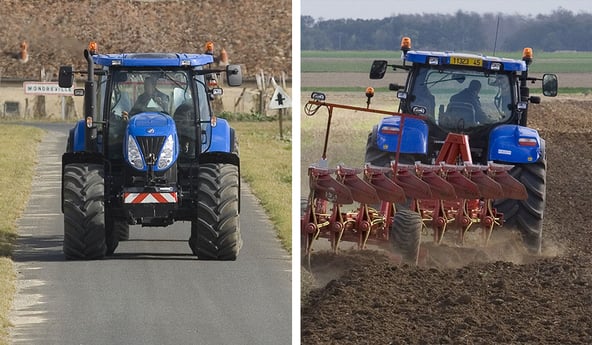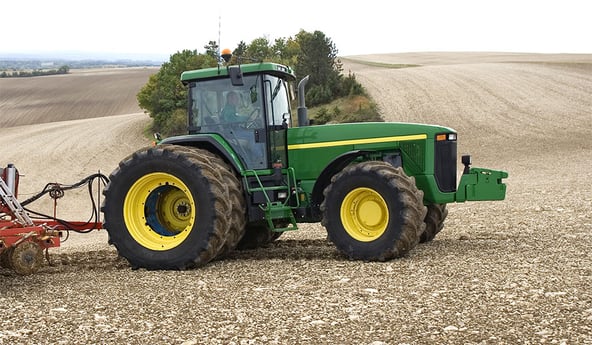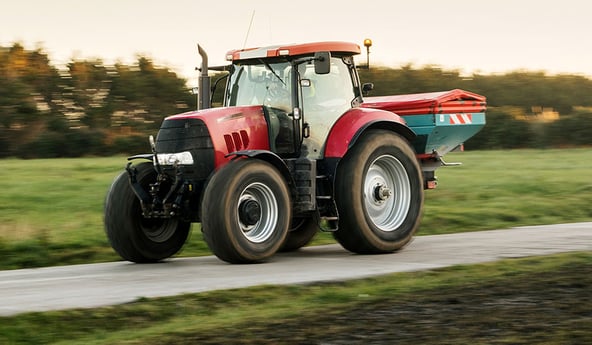It seems normal to concentrate on mechanical maintenance of tractors and tools, such as oil changes and greasing the axles, but we often forget that our tyres also deserve special care. Good tyre maintenance can extend wear life by several hundred hours (boost in hourly work rate by up to 30%) and allow you to avoid costly breakdowns. Just checking the state of your tyres regularly, especially for wear and visible defects, helps not only to prevent unexpected breakdowns during operations, but also to maintain good working results.
If you neglect basic maintenance, you may face serious problems which will cost you dearly in terms of tyre replacements and lost time. Regular, preventive maintenance is therefore a simple and efficient way of reducing maintenance costs, improving the productivity of your machines and making your tyres last much longer, whatever the type of soil or job to be done.
In this article you will find advice on good tyre maintenance depending on the time of year and your main activities:
1. Adjusting pressure is one of the key elements of maintenance for your agricultural tyres
Adjusting the pressure in your agricultural tyres is more than just a simple formality. It’s a crucial element which has a direct impact on your productivity, the longevity of your equipment and even on soil preservation.

The benefits of correct pressure settings
There are many advantages to optimal tyre settings:
- Better control of slip: by adapting pressure to the load and type of soil, you limit wheel slip, which results in better adherence and improves work efficiency.
- Optimisation of traction: suitable pressure helps to ensure an optimal contact patch between the tyre and the ground, improving your vehicle’s traction, even in the harshest conditions.
- Reduced tyre wear: the right pressure allows the tyre to work in optimal conditions, limiting friction and slip, and as such reducing premature wear.
- Decrease in fuel consumption: by reducing rolling resistance, correct pressure settings contribute to a significant reduction in fuel costs.
2. Check the rims
The state of the rims is a decisive factor for the lifespan and performance capacity of your agricultural tyres. A regular check-up will allow you to detect any defects likely to damage your tyres prematurely and as such to ensure the safety and efficiency of your equipment.
The key points to inspect during your check-up
The rims are placed under a lot of strain during their use: impacts, vibrations, overloading, variations in temperature, dampness, etc. These aggressions can deform, fissure or corrode them.
When you replace your wheels, such as when you change narrow wheels for large wheels, check that the bolts are tight after each use.

Impacts and deformations
- Tyre bead seat area: this area is particularly vulnerable. Look for any sign of impact, bumps or fissures which could compromise the tyre’s airtightness.
- Rim disc: check there is no deformation or any cracks which could cause an imbalance of the wheel as well as premature tyre wear.
Corrosion on the wheel
- Bolts: check the wheel nuts and bolts carefully. Corrosion can weaken the bolts, causing them to become progressively looser, leading to vibrations.
- Surface of the rim: rubbing or corrosion can attack the metal of the rim, breaking down its resistance and leading to fissures.
- Bead seat: stones, bits of earth or branches can get stuck between the metal and the bead, causing rubbing and premature tyre wear.
The consequences of a rim in bad condition
A damaged rim can have many negative consequences:- Premature tyre wear.
- Loss of airtightness.
- Wheel imbalance.
- Risk of coming off the rim.

How to maintain rims correctly?
Inspect them regularly to see if there are any bumps or defects. Clean your tractor wheels regularly. If you notice anything out of order, don’t hesitate to replace the damaged rim.

3. Regular mechanical check-ups are a part of maintenance
Regular mechanical maintenance of your tractor wheels and steering is essential to ensure longevity and optimise performance levels. An incorrect alignment of the wheels, especially a problem with parallelism, can cause premature tyre wear and affect the stability of your vehicle.
Checking parallelism
Parallelism corresponds to the alignment of your wheels compared to the centerline of the tractor. Incorrect settings can have harmful consequences on tyre lifespan and tractor handling ability.
The consequences of incorrect parallelism are multiple:
- Irregular tyre wear.
- Reduced tyre adherence to the ground.
- Discomfort during use on the road.
- Extra fuel consumption
- Premature wear to mechanical components: steering, suspension.
How to detect a problem with parallelism?
Several signs can alert you to this problem:
- Irregular wear: excessive wear to a specific part of the tyre, either on the inside or the outside.
- Vibrations: when driving, you may feel abnormal vibrations, in particular when travelling at speed by road.
- Road handling problems: your tractor may have a tendency to pull to one side or the other, even when you try to drive in a straight line.

4. Maintenance schedule for your tyres depending on the time of year and activities
The table below proposes a maintenance timetable adapted to the different periods of the year and corresponding agricultural activities. This is a precious tool for optimising tyre lifespan and guaranteeing your equipment’s performance capacity.
Maintenance timetable based
on periods of the year and activities
| Jan. | Feb. | March | April | May | June | July | Aug. | Sept. | Oct. | Nov. | Dec. | |
|---|---|---|---|---|---|---|---|---|---|---|---|---|
| Ploughing | ||||||||||||
| Sowing | ||||||||||||
| Spraying/spreading | ||||||||||||
| Crop protection | ||||||||||||
| Haymaking | ||||||||||||
| Harvest (wheat, barely, rapeseed, corn, sunflower) | ||||||||||||
| Cereal transport | ||||||||||||
| Potato harvesting | ||||||||||||
| Corn silage | ||||||||||||
| Beet harvesting | ||||||||||||
| Beet transport | ||||||||||||
| Chicory harvesting |
Identification of loads (weight)
Inflation pressure control
Wheel inspection (metal parts + tyre)
Mechanical inspection
Why is maintenance linked to agricultural periods or activities?
Weather conditions and types of soil evolve over the year, which has a direct impact on tyre pressure and tyre wear, and each agricultural activity solicits the tyres in a different way.
For example, tilling requires lower pressure than transporting harvests by road. And lastly, the load transported by the tractor has a direct influence on the tyre inflation pressure required.
There is no fixed ideal tyre pressure. It must be adapted based on different factors:
Periods of the year
- Dry periods: you can work at the pressure recommended by the manufacturer for your load. There is no point in reducing pressure if the ground bearing capacity is very good.
- Wet period: lower tyre pressure is generally recommended to increase the soil footprint, improve traction and limit compaction.
Types of activities
- Transport by road: higher pressure is necessary to reduce rolling resistance and ensure good road handling.
- Work in the fields: preference should be given to lower pressure to improve traction and limit soil compaction.
- Specific activities: sowing, tilling or harvesting operations require specific pressure adjustments depending on the implements used, the type of soil and the weather conditions.
Don’t hesitate to adjust the inflation pressure on the basis of the conditions, taking into account the load and the working speed.
To make the job easier, consult your tyre manufacturer recommendations.
5. The other key points in agricultural tyre maintenance
Maintenance of agricultural tyres is not just a question of adapting pressure settings. Good handling and suitable storage conditions are essential if you wish to extend their lifespan.
Tyre handling: a task that requires precautions
Agricultural tyres are heavy and cumbersome, and require special handling. A few simple rules will help avoid accidents or damage to your equipment:
- Use the right lifting tools: fork lift truck, pallet truck, hoists...
- Avoid lifting the tyres by their beads: the beads are the most fragile part of a tyre. Tyres should always be lifted by the tread.
- Do not use chains to hoist up the tyres: chains may damage the structure of the tyre. Use suitable straps instead.
- Beware of impacts: tyres must be handled with care to avoid twisting or folds which could damage them.
How to store tyres correctly?
Inappropriate storage can rapidly damage your equipment. Here are some tips on how to store your tyres in the best possible conditions:
- Choose a dry spot away from direct sunlight: UV rays can damage the tyre rubber. A garage or dark barn would be ideal.
- Protect the tyres: avoid storing tyres close to sources of heat, damp or chemical products (fuel, solvents…).
- Clean them before storage: remove any trace of earth, mud or other products that could lead to corrosion.
- Avoid stacking them in a high pile: the tyres at the bottom of the pile could end up misshapen under the weight of the tyres above.
- Change their position regularly: if they are stored flat, we recommend that you turn them around often to avoid the same area being always in contact with the ground.

Tyre storage errors to avoid
- Leaving the tyres outside: bad weather (sun, rain, frost) causes the rubber to deteriorate rapidly.
- Store tyres close to sources of heat: the heat accelerates the ageing of the rubber.
- Using chemical products to clean the tyres: certain products can attack the rubber, especially solvents and hydrocarbons.
By following this advice, you will extend your agricultural tyre lifespan and make savings in the long run.
6. Not all tyres require the same maintenance
Not all agricultural tyres are equal in terms of maintenance. Technological developments have made it possible to develop tyres that are more and more efficient, requiring less attention and offering a longer wear life.
VT-Tractor tyre: versatility and time saving
Bridgestone’s VT-Tractor tyre is an excellent example of this progress. Thanks to its VF (Very High Flexion) technology, it offers exceptional flexibility which allows it to adapt to different terrains and working conditions.
- Possibility of going from field to road while keeping the same inflation pressure
No more annoying adjustments or waste of time! The versatility is possible thanks to its technology and its very supple yet resistant sidewalls which adapt to the load and the terrain.
The VX-Tractor tyre: excellent wear life
The VX-Tractor tyre is another example of the latest generation of agricultural tyres. What makes it stand out, is its exceptional lifespan.
- More resistant rubber
The VX-Tractor tyre has 20% more rubber than the previous models. This feature makes it more resistant to wear, which extends its wear life considerably. - A reinforced structure
The casing of the VX-Tractor is designed to withstand the harshest level of strain. It provides excellent stability and limits the risk of breakdowns.

CONCLUSION
Good maintenance of your tyres is essential to increase their lifespan and keep a tight control of costs.
Correct pressure adjustments, a regular inspection of the state of the rims and accurate parallelism improve efficiency and limit wear, allowing you to make savings on tyre replacements and fuel.
At Bridgestone, we have innovative models such as VT-Tractor and VX-Tractor tyres which illustrate agricultural tyre developments perfectly.
Thanks to innovative technologies, they help to reduce time spent on maintenance significantly and to optimise your schedule.
To learn more about ways to increase your farm’s productivity, bridgestone-agriculture has created a comprehensive eBook on the topic which is available for you to download for free:
Bridgestone-agriculture Blog is written and administered by tractor tyre experts who are available to provide you with advice on agricultural tyres. They will help you to maximise your productivity with information on all things relating to tyres: inexpensive tractor tyres, technical data for agricultural tyres, solutions for avoiding soil compaction, sprayer tyre pressure, why and how to ballast your tractor tyres, when to use dual-wheels, the mechanical causes for abnormal wear, discounted agricultural tyres, etc.
Most people who read this article have also read some of the following articles:
- 10 tips to reduce abnormal wear to your farming tyres
- When can you carry out cold repairs on tractor tyres?
- 5 problems on the bead of an agricultural tyre which mean it has to be replaced
- Does unsuitable inflation pressure accelerate wear to my agricultural tyres?
- What are the 4 top stress factors for your agricultural tyres?
- What impact does stubble have on my tractor tyre wear?
- Why don’t my agricultural tyres last long enough?
- Which agricultural tyre model has the most competitive hourly cost?
- Which agricultural tyre is most suitable for road transport?
- What has the most impact on the hourly cost of an agricultural tyre?
This information is intended only to make you aware of the technical and functional aspects of agricultural tires and their use. It does not allow you to make a judgment or a definitive conclusion on a given problem. Only your agricultural tire expert is able to make a technical assessment and take a final decision, case by case.
Leave a
commentary
Your email address will not be published.
Required fields are indicated with *








